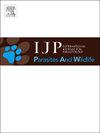Galápagos雀形目中检出新型微丝蚴
IF 2.2
3区 医学
Q3 ECOLOGY
International Journal for Parasitology-Parasites and Wildlife
Pub Date : 2025-07-12
DOI:10.1016/j.ijppaw.2025.101115
引用次数: 0
摘要
新出现的寄生虫对野生动物种群的健康和生存构成严重威胁,特别是在物种往往缺乏事先接触和进化出防御能力的岛屿上。本文首次报道了在圣克鲁斯岛沿海地区6种Galápagos雀鸟的血液中发现的一种新型微丝虫感染。在13个月的时间里,跨越两个雨季和一个旱季,294个个体被取样,并通过显微镜和/或聚合酶链反应评估微丝虫的存在。我们对线粒体细胞色素c氧化酶I (COI)基因进行了条形码编码,初步将该微丝虫归入真丝虫属。我们发现寄主物种的感染水平存在差异,某些物种,如素食雀(Platyspiza crassirostris)和常见的仙人掌雀(Geospiza)。scandens)的患病率非常高,而其他的,如Galápagos仿舌鸟(Mimus parvulus)和小树雀(Camarhynchus parvulus)的患病率明显较低。我们通过白细胞计数、H/L比值和身体状况来评估感染对鸟类的潜在影响,发现感染状况与这些健康指标没有关系。我们还测试了季节性是否可以预测我们数据中发现的感染趋势,并发现了与月降雨量的关系,其中降雨量越多,微丝虫的流行率就越高。虽然我们不能确切地确认这种寄生虫是何时在Galápagos建立的,但我们的研究强调了在地方性系统中持续监测疾病的重要性,并强调了物种水平COI条形码的必要性,以改善微丝虫的鉴定和系统发育。本文章由计算机程序翻译,如有差异,请以英文原文为准。

Novel microfilariae detected in Galápagos passerines
Emerging parasites pose a serious risk to the health and survival of wild animal populations, particularly on islands where species often lack prior exposure and evolved defenses. We present the first report of a novel microfilaria infection found in blood from six species of Galápagos passerines in the coastal zone of Santa Cruz Island. Across 13 months, spanning two wet seasons and one dry season, 294 individuals were sampled and evaluated for microfilarial presence through microscopy and/or polymerase chain reaction. We barcoded the mitochondrial Cytochrome c oxidase I (COI) gene to tentatively place this microfilaria in the genus Eufilaria. We found host species level variation in infection, with certain species, like the vegetarian finch (Platyspiza crassirostris) and the common cactus finch (Geospiza. scandens) having very high prevalence, while others, like the Galápagos mockingbird (Mimus parvulus) and small tree finch (Camarhynchus parvulus) showing significantly lower prevalence. We investigated leukocyte counts, H/L ratios and body condition to evaluate the potential effects of infection on birds and found no relationship between infection status and these health indices. We also tested to see if seasonality could predict the infection trends found in our data and found a relationship with monthly rainfall, where more rain predicts higher microfilarial prevalence. Although we cannot confirm exactly when this parasite established in the Galápagos, our study highlights the importance of continued disease surveillance in endemic systems and underscores the need for species-level COI barcodes to improve microfilaria identification and phylogenetics.
求助全文
通过发布文献求助,成功后即可免费获取论文全文。
去求助
来源期刊

International Journal for Parasitology-Parasites and Wildlife
Medicine-Infectious Diseases
CiteScore
3.80
自引率
5.60%
发文量
113
审稿时长
45 days
期刊介绍:
The International Journal for Parasitology: Parasites and Wildlife (IJP-PAW) publishes the results of original research on parasites of all wildlife, invertebrate and vertebrate. This includes free-ranging, wild populations, as well as captive wildlife, semi-domesticated species (e.g. reindeer) and farmed populations of recently domesticated or wild-captured species (e.g. cultured fishes). Articles on all aspects of wildlife parasitology are welcomed including taxonomy, biodiversity and distribution, ecology and epidemiology, population biology and host-parasite relationships. The impact of parasites on the health and conservation of wildlife is seen as an important area covered by the journal especially the potential role of environmental factors, for example climate. Also important to the journal is ''one health'' and the nature of interactions between wildlife, people and domestic animals, including disease emergence and zoonoses.
 求助内容:
求助内容: 应助结果提醒方式:
应助结果提醒方式:


